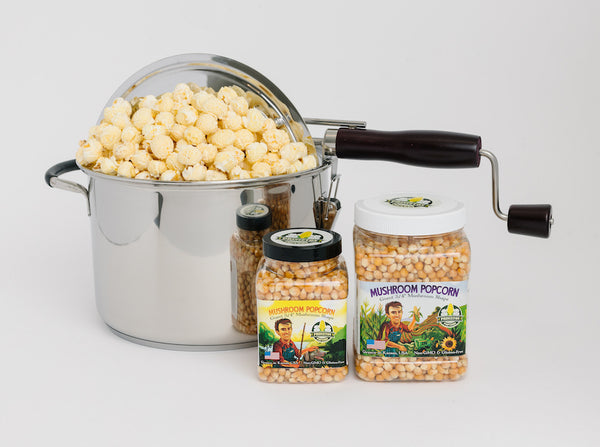Popcorn Popping Tips - How to pop mushroom popcorn great every time
What is Popcorn Anyway?
Popcorn is the seed of a grass plant. Popcorn is one variety and you may recognize the names of the others; Sweet Corn, Flint Corn, Field Corn / Dent Corn. The popcorn variety happens to have a very tough outer shell.
Popcorn Popping Concept
You really have to understand the way popcorn works to be able to achieve the best results. We provide popping tips, not instructions. The reason for this is because popping our variety involves science but is not an exact science. There are a lot of variables that need to be taken into consideration. Please understand it will likely take you a few tries to get optimum results!
In short, you want to introduce the kernels to a lot of heat really quickly without burning them. This will cause the moisture held inside the kernel by the hard outer shell (later referred to a 'hull') to turn into steam and increase internal pressure. Once the internal pressure becomes too great, there is an explosion which turns the insides inside-out. The white fluffy stuff we eat is the expanded insides of the popcorn seed.
To achieve the best pop ability, seed breeders select for different traits. Some include the thickness of the outer shell, the way the popcorn pops (ie shape), the size of the kernel, the quantity of kernels on a cob, the size of the cob (effects yield), how well the plant resists pests and fungus (you have to be able to successfully grow it to harvest a product), etc.
Our popcorn variety is a hybrid where the breeder, which we work closely with, introduces the two specific parent plants to achieve the offspring with the desired traits. Our popcorn is Non-GMO. The mushroom shaped popcorn is a trait achieved in breeding. Princeton Popcorn's Mushroom Shaped variety pops that way because of plant genetics combined with a popping method. You have to have both to achieve the mushroom shape.
After we plant and raise the popcorn, we have to harvest at the right time. The moisture content of the kernels in the field has to be just right. It has to be low enough that the kernels will shatter off of the cob while harvesting but not too low that they will crack and break. If the harvested popcorn is too high in moisture, it can spoil in storage. If it is too low, it won't pop. We have very expensive drying and conditioning equipment on our farm to get the popcorn to the specific, all-important moisture level.
When we package the popcorn to offer it for sale to you, we ensure that the moisture level is just right. The package we sent to you is sealed to prevent the moisture content from going up or down. Please be sure to put the lid back on the container between uses!
How to Pop on the Stove-top
Stove popping with oil is the same concept. A good oil-to-popcorn ratio is about 2 tablespoons for a 1/2 cup of popcorn or 1 tablespoon for 1/4 cup. Put the oil in the pan (I love olive oil) and turn the heat up to high. With a good oil with a high flash point, you really don't have to worry too much about burning the oil. Put 3 kernels in the oil and wait until they pop. Then, dump the rest of the kernels in. Keep agitating the pan by shaking it back and forth. You don't want the kernels to burn before they have a chance to pop. With the high heat, they would if you just leave them in the pan. Once they start to pop they will, likely, pop vigorously. Once popping slows, remove from heat. In my experience it seems like they all start popping at once and go for a bit and then taper off quickly. Keeping the pan moving during this time is the key to getting all the kernels to pop!!! You need to let gravity get the unpopped down to the heat source by agitating the pan.
Good oils to use include:
- Sunflower oil - High Oleic Acid
- Extra-virgin olive oil (Farmer Bob's Favorite)
- Peanut oil (unless you have a peanut allergy)
- Palm oil (not Palm Seed oil) (warning, high saturated fat)
- Coconut oil (warning, high saturated fat)
- Vegetable oil (typically a generic term for a blend of various ones)
- Canola oil
- Grapeseed oil
- Avocado oil (very expensive and, in our experimentation, doesn't add a ton of taste but is very healthy.)
- Sesame oil
- Hemp seed oil
Oils to avoid:
- Flaxseed oil
- Wheat Germ oil
- Corn oil (seems weird to use, right?)
- Soybean
How to Pop with Hot Air
So, in air popping, you want to run the air popper for a minute or two before you put your kernels in. That way the air popper is good and warmed up so they will pop great. Remember, you need to introduce high heat immediately. If you introduce it slowly by putting the kernels in the air popper and then turning it on, you'll slowly heat up in the moisture inside the kernel and let it leak out. The "explosion" is what you are wanting to achieve the giant mushroom-shaped popcorn.
How to Pop in the Microwave
Don't. Just don't.... Due to the way microwaves work, you will likely never achieve a good or consistent popping of our variety of popcorn. The characteristics you desire from our variety of popcorn can never manifest with the heating method a microwave uses. The popcorn certainly will pop and is edible but just won't be beautiful. You might as well use a cheaper variety of popcorn if you are going to pop it in the microwave.
Common Problems
Half-Pops
Typically this is due to high moisture content in the kernels which weakens the outer walls and prevents the buildup of steam. Since we moisture test each batch before packaging, this is less likely to be the cause in your specific case unless you have left the lid off of the package in a high humidity environment. More likely it is due to low heat. The kernel was exposed to enough heat to make it pop but not quite enough to make it a vigorous explosion.
Too many unpopped at the bottom
There are different reasons for this based upon how you pop the popcorn. If you are popping up popcorn on the stovetop, the most common cause for this is a lack of agitation while popping. You must agitate the pan while popping to allow the unpopped kernels to fall to the bottom and stay in contact with the heat source. If you do not agitate they can become lodged within the popped kernels and be removed from heat, leaving them unpopped.
In an air popper the air movement does a great job of agitating the kernels and keeping them in consistent contact with the hot air. The unpopped in this case are likely due to the popcorn popper not producing enough heat or a crack in the outer shell of the popcorn seed.
With either method, it is acceptable to have some unpopped kernels left. In our test popping, oftentimes we have zero kernels left unpopped! But, it is reasonable to expect some when you consider the mechanical harvesting by combine in the subsequent machine handling which includes auguring from the grain bin into the seed cleaner and packaging.
Burned popcorn
Burned popcorn after it has popped is the direct result of leaving the pan on the stove top too long. Obviously you desire to have all the kernels pop but you should not do so at the expense of burning the popped popcorn. The best rule of thumb is when most popping stops, remove it from heat immediately.
It is unlikely you would get burned popcorn from a hot air popper.
Burned popcorn kernels
If you have burned popcorn kernels at the bottom this simply means you left them in direct contact with the heat too long. Agitating the pan while popping will help eliminate this if the kernel is actually pop-able. Potentially, the kernel has a crack in the outer shell and will not pop so it remains in contact with the heat and burns. While it is acceptable to have some kernels that do not pop, it is not good to leave popcorn on the heat source too long, risking the whole batch.
Here are the best devices for stovetop and air popping.
The "Time for Treats" is the heavy-duty version and best suited for those who pop popcorn frequently. The Great Northern one has a more crude construction and will not hold up to daily popping, especially with our popcorn. Princeton Popcorn is more physically substantial than traditional popcorn and will wear the Great Northern out quickly.
Hands down, the BEST popper! This is highly recommended by Farmer Bob and this is what we use to test-pop our product. It is seemingly pricey but the construction quality and feature set are well worth the cost.
https://princetonpopcorn.com/products/stovetop-popcorn-popper-heavy-duty
Hot Air Poppers
Crank Type Oil Poppers
Old Fashion / Movie Theater Type
Auto Spinner Type
Microwave? We do not recommend popping our variety of popcorn in the microwave. It will pop but not as glorious as it should and likely not in the mushroom shape. However, customers have reported they do and it turns out ok.
Step-by-step:
1) Put stove on HIGH setting.
2) Put oil in the pan. Olive oil works great but canola or coconut work as well. Don't skimp on the oil. If you use too little, it effects popping negatively. Remember, the oil is the heat transfer mechanism and you want the popcorn kernels exposed to a lot of heat quickly.
3) Let the oil heat up until you see steam coming off of the oil. At this point, it is evaporating the moisture in the oil.
4) Put 3 kernels in and wait for them to pop. Likely, they will pop in close sequence; 1, 2, 3.
5) Then, put the kernels in (1/4 or 1/3 cup) and wait for them to pop. I’d agitate the popcorn by shaking the pan. When you add the popcorn, it’ll take the oil temperature down immediately as it transfers heat to the popcorn.
6) There will be vigorous popping once the kernels get to temperature. Remove from heat when you start to hear a single popping after the rapid-fire popping subsides (typically 15 seconds or so).
The goal is to get them to pop up big and in a mushroom shape. The genetics are there to pop in that shape. But, you have to have the kernel moisture content right (our job and that is why we test before we pack) but you also have to have the heat right.
You want it HOT so it’ll convert the water in the kernel to steam so you have a steam explosion inside the kernel. If you have it too hot and don’t agitate the kernels, they will burn and not pop. So, it is somewhat of a juggling act but it is very possible.


